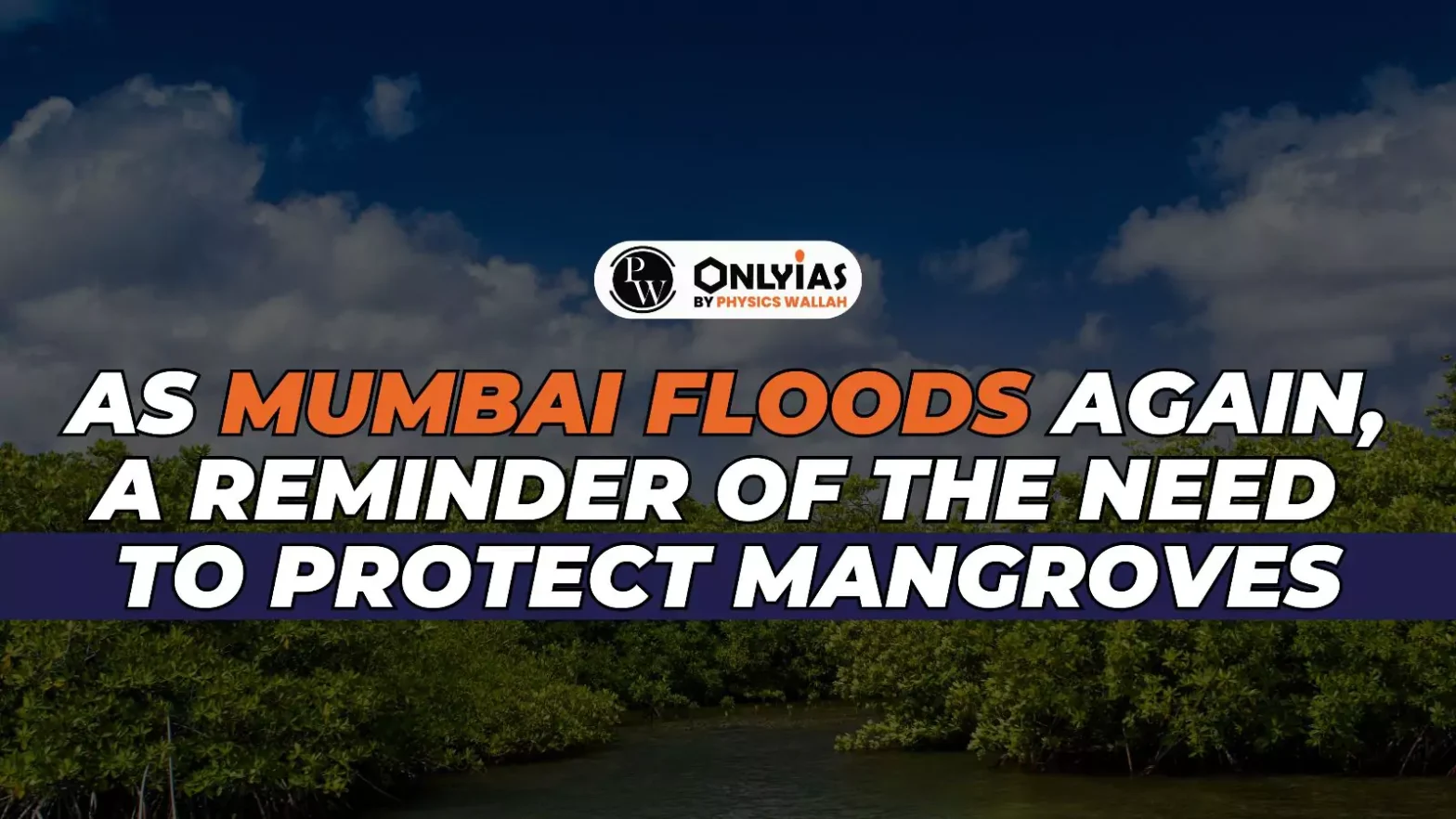Across India’s coastline, and especially in vulnerable megacities like Mumbai and Chennai, large infrastructure projects continue to threaten invaluable ecosystems like mangrove forests.
Mumbai Floods Again
- Currently, torrential rainfall in parts of Maharashtra has caused flooding, including in Mumbai.
- When developing transport networks or expanding ports, policymakers should acknowledge and address the trade-offs and consequences of tinkering with nature.
- Instead, planners are often perpetuating an outdated model of urbanisation that prioritises humanengineered grey infrastructure at the expense of intact habitats.
- In the long term, this will only increase the costs of adapting to and addressing the swelling tide of challenges in a heating world.
- Half of the world’s mangroves are at risk due to human activities and climate change, according to a recent assessment by the International Union for Conservation of Nature.
Enroll now for UPSC Online Course
The Cost of a Not-So-Green Urbanisation
- India has lost 40 per cent of its mangrove cover over the last century, as per an Indian Institute of Science study.
- Mumbai experienced devastating flooding on 26 July, 2005.
- A cloudburst led to a punishing downfall which claimed 698 lives. Over a lakh houses were destroyed, 20,000 cars were damaged and over 24,000 animals died.
- The date is now observed as the International Day for the Conservation of the Mangrove Ecosystem.
- In 2015, Chennai too, met a similar fate.
- After unprecedented levels of rainfall, the city came to a standstill and over 200 people lost their lives
- But as conservation efforts embrace local communities’ knowledge and new technological tools, we have a much better understanding of the benefits provided by bio shields like mangroves.
- With their stilt-like arched aerial roots, mangrove forests dissipate the energy of large waves and protect people and infrastructure from flooding as it becomes more frequent due to poor planning choices and more intense storms.
- Current global estimates suggest mangroves provide flood protection benefits of up to $65 billion each year.
- Mangroves also store four times more carbon than the equivalent area of a tropical forest, provide a nursery for juvenile fish and a home to many other
Tailwinds of Change
- Fortunately, there are tailwinds that could reverse the destruction of these marvels of nature.
- At the international level, the Global Mangrove Alliance and Mangrove Alliance for Climate (of which India is a member) are fostering collaboration, fostering and utilising ambition for protection and restoration, and raising resources for this ecosystem.
- Domestically, mangroves are part of India’s 2030 target of creating a sink of 2.5-3 billion tonnes of carbon dioxide equivalent through additional green cover.
- Mangroves were included in the Budget 2023-24 through the Amrit Dharohar scheme, centred around ecotourism and the role of local communities in the conservation of Ramsar Sites, and the Mangrove Initiative for Shoreline Habitats and Tangible Incomes (MISHTI), which aims to restore more than 500 square kilometres of mangroves over the next five years.
- States are also taking key actions: The Maharashtra Mangrove Cell has commissioned a two-year satellite-based assessment of the state of mangroves across its coastline, and the Green Tamil Nadu Mission has allocated a budget of Rs 1,000 crore to increase forest cover (including coastal forests) from 23 to 33 per cent.
Check Out UPSC Modules From PW Store
How We Can Help
- Civil society can play an important role in assisting these efforts, acting as a bridge between policy, local communities and scientific research.
- This could strengthen policy frameworks and practices on the ground.
- Over the next couple of years, the Soonabai Pirojsha Godrej Foundation will be anchoring a Mangrove Coalition focused on Mumbai and Chennai that aims to enhance the protection and management of urban mangroves through an interdisciplinary, integrated and inclusive approach to conservation.
- The coalition’s three key pillars of work could be relevant to efforts at safeguarding other ecosystems too.
- First, our partners will work with decisionmakers using the logic of “natural capital” towards quantifying ecosystem services in different development scenarios.
- This will be an effort towards reversing patterns of urban planning in which blue and green infrastructure like creeks and forests have been undervalued as compared to human-engineered grey infrastructure.
- In addition to the carbon storage, biodiversity benefits and coastal and flood protection described above, mangroves also mitigate the effects of urban heat islands, provide air quality benefits, and offer opportunities for tourism and recreation.
- Second, as we think about the multilayered governance of these urban ecosystems, we plan to engage deeply with local communities who have often been left out of decision-making because of a “fortress style” of conservation.
- Through understanding the land-use dynamics between mangroves and urban settlements and envisioning possibilities for livelihoods in addition to fishing and crab farming, we hope to partner with communities towards stewardship of these habitats.
- As India rapidly urbanises, we need a new paradigm that preserves the commons for the people whose lives are most directly intertwined with these spaces.
- Third, we plan to conduct participatory ecological studies involving local community members, students, and wildlife enthusiasts.
- In addition to deepening people’s connection to urban ecosystems, such citizen science efforts can generate valuable data about flora and fauna that could help inform a Mangrove Health Index.
- From Koli fisherfolk documenting what they’re finding in their nets to birdwatchers through their binoculars, urban citizens from varied backgrounds are often closest to observing nature’s wonder as well as its transformations.
Enroll now for UPSC Online Classes
Conclusion
To combat flooding and climate impacts, prioritizing mangrove conservation and integrating natural ecosystems into urban planning are essential for sustainable development and community resilience.
![]() 27 Jul 2024
27 Jul 2024

